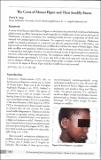| dc.description.abstract | A survey of the Kenyan side of Mount Elgon revealed numerous caves which were found harbouring phlebotomine sandflies. Among the morphologically identifiable males of rwo species of the genus Phlebotomus, sub-genus Larroussius were indistinguishable females, a proportion of which were infected with promastigotes of Leishmania. The suspected vector of this parasite, Phlebotomus pedifer was found predominant in a relatively low altitude escarpment belt at l 750- l 900m, and represented over half of the identified male sandflies detected from the slopes of Mount Elgon. These male sandflies were associated with females infected with Leishmania and those which bit man. At intermediate and higher altitudes, the caves harboured mainly P.elgonensis and were associated with river valleys and major promontories. The escarpment which is a proven focus of cutaneous leishmaniasis was approximately 257 sq km and 10% of the study area, and took the form of a narrow, elongate cliff along the entire southern slopes of the mountain. Details of the distribution of caves on the slopes of Mount Elgon and their sandfly fauna are presented. | en_US |

